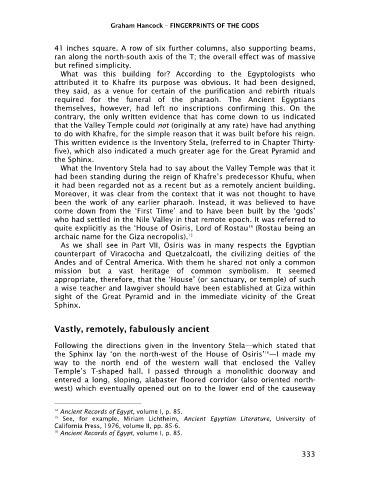Page 335 - Fingerprints of the Gods by Graham Hancock
P. 335
Graham Hancock – FINGERPRINTS OF THE GODS
41 inches square. A row of six further columns, also supporting beams,
ran along the north-south axis of the T; the overall effect was of massive
but refined simplicity.
What was this building for? According to the Egyptologists who
attributed it to Khafre its purpose was obvious. It had been designed,
they said, as a venue for certain of the purification and rebirth rituals
required for the funeral of the pharaoh. The Ancient Egyptians
themselves, however, had left no inscriptions confirming this. On the
contrary, the only written evidence that has come down to us indicated
that the Valley Temple could not (originally at any rate) have had anything
to do with Khafre, for the simple reason that it was built before his reign.
This written evidence is the Inventory Stela, (referred to in Chapter Thirty-
five), which also indicated a much greater age for the Great Pyramid and
the Sphinx.
What the Inventory Stela had to say about the Valley Temple was that it
had been standing during the reign of Khafre’s predecessor Khufu, when
it had been regarded not as a recent but as a remotely ancient building.
Moreover, it was clear from the context that it was not thought to have
been the work of any earlier pharaoh. Instead, it was believed to have
come down from the ‘First Time’ and to have been built by the ‘gods’
who had settled in the Nile Valley in that remote epoch. It was referred to
quite explicitly as the ‘House of Osiris, Lord of Rostau (Rostau being an
14
archaic name for the Giza necropolis).
15
As we shall see in Part VII, Osiris was in many respects the Egyptian
counterpart of Viracocha and Quetzalcoatl, the civilizing deities of the
Andes and of Central America. With them he shared not only a common
mission but a vast heritage of common symbolism. It seemed
appropriate, therefore, that the ‘House’ (or sanctuary, or temple) of such
a wise teacher and lawgiver should have been established at Giza within
sight of the Great Pyramid and in the immediate vicinity of the Great
Sphinx.
Vastly, remotely, fabulously ancient
Following the directions given in the Inventory Stela—which stated that
the Sphinx lay ‘on the north-west of the House of Osiris’ —I made my
16
way to the north end of the western wall that enclosed the Valley
Temple’s T-shaped hall. I passed through a monolithic doorway and
entered a long, sloping, alabaster floored corridor (also oriented north-
west) which eventually opened out on to the lower end of the causeway
14 Ancient Records of Egypt, volume I, p. 85.
See, for example, Miriam Lichtheim, Ancient Egyptian Literature, University of
15
California Press, 1976, volume II, pp. 85-6.
16 Ancient Records of Egypt, volume I, p. 85.
333

